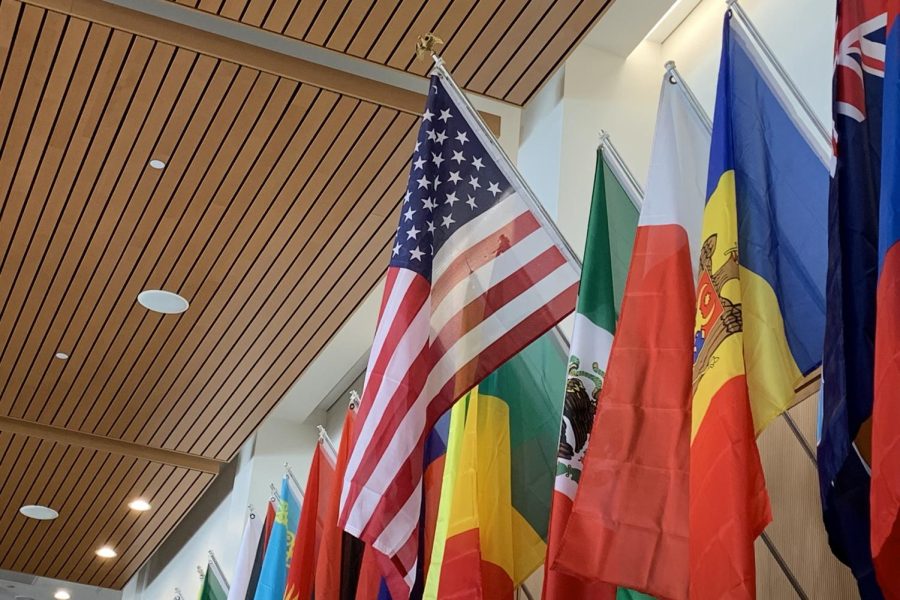Opinion: Winter Week psych alteration reflects our changing perception of patriotism
Credit: Alyssa Ao
WSPN’s Alyssa Ao and Bella Schreiber discuss how a Winter Week psych theme connects to the current definitions of patriotism in America.
March 4, 2022
Traditionally, Wayland High School students celebrate during Winter Week following the end of midyear exams. This year, despite the cancellation of midterms, students still participated in a week full of fun events and outfit psychs. Winter Week was originally scheduled to end with Friday’s psych, U.S.A. Day.
“Show your patriotic pride and wear red, white and blue,” WHS Student Council President Luciano Sebastianelli said in an email to students.
Plans changed on the penultimate day of Winter Week, Thursday, Feb. 3, when a schoolwide email was sent out informing students that the student council had made the decision to change the U.S.A. psych to a pajama day.
We can’t be sure of the exact details or reasoning behind the sudden switch, but it seems that the main factor was the student council wanting to avoid controversy when some students were against participating in the psych, and instead they planned to wear all black on Friday in protest.
So why did some students have issues with the idea of a U.S.A. psych?
Personally, when first reading the planned psychs for Winter Week, we rolled our eyes when we saw that a “patriotic” U.S.A. day was scheduled. It just felt unnecessary to us. We weren’t planning on participating. We couldn’t see anything fun about the idea, unlike Anything But a Backpack Day or Decades Day where students could be creative or over-the-top. When one imagines someone going similarly “extra” for a U.S.A. day, they don’t picture anything nearly as fun. In fact, the imagery even felt vaguely uncomfortable. Why is that?
For most of us, patriotism is taught from a very young age. Many American kids are told that America is the “greatest country in the world.” Families bring their children to Fourth of July picnics and firework shows, where the sky is red, white and blue all over. In Massachusetts, public schools are required by law to have an American flag in every classroom. We remember reciting the Pledge of Allegiance every day in elementary school and weekly in middle school. A 2016 survey from YouGov found that 41% of U.S. participants agreed with the statement “[My country] is the best country in the world,” the highest percentage out of 19 countries.
There are some aspects of patriotism that are positive. It can promote a sense of unity. It’s a good thing to feel pride in your country’s achievements and people. The YouGov survey demonstrates that America is far from the only place where citizens believe their country is “the best,” or at least better than most other countries.
That pride becomes problematic when it borders on chauvinism, the idea that foreign countries and people are inferior, and that America is always faultless. In recent years, more and more attention has been drawn to the injustice and inequality deeply ingrained in American society. The killing of George Floyd by police and the efforts of the Black Lives Matter movement made many, both within and outside America, finally open their eyes to the racism and discrimination that has cost countless other Black Americans their lives.
So many Americans still experience the consequences of the brutal inequality that pervades our country’s history. Claiming that America is the greatest country, in spite of the suffering of generations of marginalized groups, often serves to brush over the harsh realities of our past and present.
Today, we find ourselves, more often than not, associating the U.S. flag with Donald Trump and his “Make America Great Again” branding. We picture hate mobs wearing the flag on their backs, with people brandishing it at protests, as though advocating for the Black Lives Matter movement is in itself un-American.
We’re not alone in this, either. In light of everything that has happened in the U.S. in just the past few years – the pandemic, the heightened political tension, the capitol riot – red, white and blue has taken on a new meaning for much of the country. On various social media platforms, wearing the American flag has jokingly been described as a “red flag,” with underlying implications of the wearer being an anti-masker, anti-vaxxer, bigot and a number of other connotations that most want to avoid. Maybe, this is overly broad or judgmental, but nevertheless it’s an association that’s now carried by many.
Often, those who aren’t “patriotic enough” face severe backlash. Whether it’s “disrespecting” the flag, the national anthem, the Pledge of Allegiance or any other representation of patriotism, people who don’t demonstrate the proper reverence or enthusiasm are labeled anti-American.
It seems extreme to connect all this to a one-day Winter Week event at our high school. However, it’s important to understand why these conversations are being held, and why some students were less than pleased with the concept of the psych. The students who planned to wear black in protest were pushing for an acknowledgment of the problems with today’s patriotism. It is ignorance to celebrate America in all her glory without seeking to understand the many deeply-rooted issues that continue to plague our country.
There is nothing wrong with wanting to express pride in your country. There’s nothing wrong with simply wearing or displaying the flag, either. Patriotism is not inherently bad or offensive. It only becomes ignorant when that patriotism is blind, when being a “true American” means refusing to question our history or ongoing problems, or when the symbols of our nation are used to discredit differing opinions or movements for equality.
Personally, if we had been involved in the decision to change the psych, we wouldn’t have wanted to drop the theme completely. Instead, we think it would have been a more effective solution to adjust the psych to include other countries and places in the world as well as the U.S. Students could have worn colors that represent any nation that they are proud of, have lived in or that they want to learn more about. Holding a more inclusive psych could have been a deliberate effort to signify an open environment and conversation for students.
Whether discussing a small community like Wayland, or the entire country, it is important for all of us to consider the shifting context and implications surrounding our traditional symbols. Our pride in our country should be directed towards our potential to grow and improve upon our flawed systems, rather than a blind glorification of our history in the name of patriotism.





![Last Wednesday, the Wayland School Committee gathered to discuss a number of topics regarding the health curriculum and Innovation Career Pathway course. Another large topic of conversation was the ways to potentially mitigate distracting cell phone usage. "These [phones] are going to distract your learning and social relationships," Superintendent David Fleishman said. "That's concrete right there."](https://waylandstudentpress.com/wp-content/uploads/2025/06/Screenshot-2025-06-04-at-9.49.31 PM-1200x886.png)



























![Troy Hoyt finishes the Boston Marathon, running for the Hoyt Foundation. T. Hoyt is the son of Hoyt Foundation CEO Russ Hoyt.
“[Running a marathon] might seem like a big thing, when it’s presented to you at first, but if you break it up and just keep telling yourself, “Yes, you can,” you can start chipping away at it. And before you know it, you’ll be running the whole 26 miles, and you won’t even think twice about it.” T. Hoyt said.](https://waylandstudentpress.com/wp-content/uploads/2025/04/C36E8761-1CBB-452E-9DF2-543EF7B1095E_1_105_c.jpeg)














































